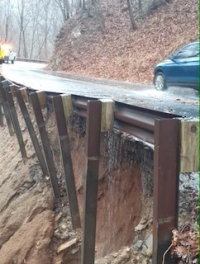We’ll weather the weather, whatever it is
One of my daughter Izzy’s favorite videos is “Little Bear’s Winter Tales.” She likes the episode with the blizzard. The mantra for the characters becomes, “Whether the weather is hot or whether the weather is cold, we’ll weather the weather whatever the weather, whether we like it or not.” It seems like an appropriate mantra for Western North Carolina.
Cornell – it’s more than just ivory-billeds
Cornell University and the ivory-billed woodpecker have been inextricably linked since the announcement in 2005 of the rediscovery of the ivory-billed in the Big Woods of Arkansas. Cornell Lab of Ornithology (CLO) has embraced that link. It’s featured prominently on its Web site — the last time I checked, it was the most visited segment — and in their solicitations. There is also a bit of an undercurrent out there of skeptics (including me) who feel that Cornell Lab of Ornithology has not provided an airtight case for its claims. Regardless of where you stand on that issue, there is more to CLO than just ivory-billed woodpeckers.
Trees up close and personal
Winter is a great time for studying tree identification. The mountains look steel-gray from a distance. The forest, up close, is a study in muted earth tones. There’s bark, smooth grey bark, scaly, nearly black bark, fissured gray bark and papery yellow bark to name a few. There are terminal buds, auxiliary buds and lateral buds. Twigs may be hairy (pubescent) or smooth (glabrous). By learning these characters and characteristics, you can turn a winter forest of cold gray and brown timbers into a living forest of black cherry, red maple, basswood, mockernut hickory, Southern red oak, Northern red oak, etc.
Holiday Bird Nerd Diary: Yellow-headed blackbird highlights Balsam bird count
The Carolina Field birders, friends and volunteers conducted their fourth annual Audubon Christmas Bird Count on Thursday, Dec. 29.
A wintry mix
Christmas Day brought showers interrupted by buckets full of sleet. Sometime late Christmas night or before dawn the next morning, a dusting of snow covered the lawn. Winter precipitation is often a mix in the eastern United States. Sleet and freezing rain are almost exclusively eastern phenomena.
Eureka! Dilemma dissolved
I can’t understand how imminent ornithologists, in particular, and biologists, scientists and researchers in general have overlooked the obvious truth regarding the newly rediscovered ivory-billed woodpecker. By borrowing a well established principle from the arena of philosophy and applying it to the biological world it is easy to see the reality here. “Ockham’s razor” a theory named after 14th century philosopher William of Ockham basically states that the best explanation for almost any puzzling phenomenon is usually the simplest one.
It’s hornets vs. swans in OLF controversy
One would think swans would probably be a sure bet in such a scenario. After all, they are bigger and stronger. But these aren’t your average hornets. These are Navy F/A-18 Super Hornet jet fighters.
Bamboo by any other name
Bamboo is the common name applied to a wide and varied group of woody grasses from all around the world. There are more than 1,000 species of bamboo. Bamboo grows in temperate and tropical climates in the Americas and throughout Asia with the greatest diversity occurring in tropical areas.
Kudos for Cantrell’s new book on fish in Cherokee country
When I read the notice about a new book — The Fishes Gathered in Cherokee Country — in the Nov. 16 edition of the Smoky Mountain News, it piqued my curiosity. I contacted the book’s author, U.S. Fish and Wildlife Service biologist Mark Cantrell, who graciously mailed me a copy.
The Naturalist's Corner
The front that passed through the week before Thanksgiving brought the first waterfowl fallout of the season to Lake Junaluska. I passed by on Thursday afternoon (11/17) and observed one snow goose with a small group of Canadian geese. Friday afternoon I returned for a longer look and found one gadwall in the back of the lake near the newly designed wetlands; a number of hooded mergansers in the same area; numerous American coots there and all around the lake; a double-crested cormorant sunning itself on the little island beneath the osprey platform; and a wood duck near the entrance road off US 19. There were a couple of pied-billed grebes around the lake. A small raft in the middle of the lake contained American wigeon, ring-billed ducks and lesser scaup. A group of bufflehead were also out in the middle of the lake along with one horned grebe.





